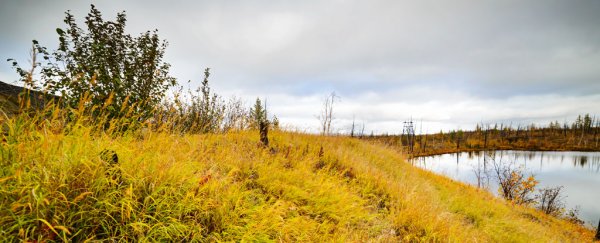A major part of tackling the climate crisis is in understanding what's happening in Earth's atmosphere in terms of heating, cooling, and the factors playing into that. Now scientists have discovered a massive new source of nitrous oxide (N2O), one of the greenhouse gases causing our planet to warm up.
This nitrous oxide source is an abundant type of permafrost called Yedoma, rich in organic material, stretching over more than a million square kilometers of land in the Northern Hemisphere.
Here the researchers studied the Lena and Kolyma Rivers in northeast Siberia, finding that as the permafrost melts along the edges of the water, it releases between 10 and 100 times the amount of nitrous oxide that would typically be expected from permafrost thaw.
"The high ice content of Yedoma makes it vulnerable for abrupt thaw and ground collapse, allowing rapid mobilization of soil carbon and nitrogen stocks after thaw," write the researchers in their published paper.
"Along Arctic rivers and the coastal zone of the Arctic Shelf, thawing of Yedoma permafrost creates steep, tens-of-meters-high Yedoma exposures, where many of the conditions known to promote N2O emissions from permafrost-affected soils are met."
Nitrous oxide is produced by microbes in the soil. While the gas isn't as abundant as carbon dioxide and methane in the atmosphere, it has a far more significant effect in terms of temperatures: It's almost 300 times stronger than carbon dioxide as a warming agent over a 100-year period.
The researchers' permafrost analysis revealed specific processes in the Yedoma that were contributing to such a high N2O output: It's partly to do with the speed that the sediments are drying and stabilizing after thawing. While nitrous oxide emissions from the melting permafrost start off slow, they quickly increase over the course of less than a decade.
What's happening in the soil as it thaws out is that the N2O-producing microbe population grows while the N2O-consuming microbe population shrinks. That changes the nitrogen cycle and means significantly more nitrous oxide is getting pushed out.
"While it is important to remember that such high N2O emissions will occur in particular settings… these conditions are not limited to the retrogressive thaw slumps along rivers studied here," write the researchers.
"Similar disturbed nitrogen-rich Yedoma with successional plant cover are widespread along thermokarst lake shores, coasts, slopes, and valleys across the Yedoma region."
In other words, the conditions here – the high ice content of the Yedoma exposed to the surface (which means rapid thawing), the right moisture levels, enough time for the microbial populations to shift – are likely to be found in plenty of other places.
Previously, researchers thought that nitrogen trapped inside permafrost wasn't a particular worry as far as climate change is concerned because nitrogen cycling in cold Arctic soil is typically very slow (high N2O emissions usually come from agriculture).
This study shows that much more research needs to be done into how much nitrogen could be stored in these cold landscapes, how quickly it might be released, and what the effects could be for global warming and these ecosystems as a whole.
"The nitrogen release from thawing permafrost can substantially improve the availability of nitrogen in Arctic ecosystems, which, in addition to the direct climatic feedback in the form of nitrous oxide, may have important consequences on carbon fixation by plants and eutrophication of water systems," says environmental scientist Maija Marushchak, from the University of Eastern Finland.
The research has been published in Nature Communications.
